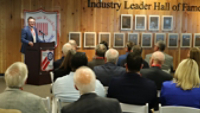Dwayne Cowan explores the (bus) ride to healthy and equitable cities

This Healthy Spaces podcast episode explores the role mass transit plays in healthier cities and quality of life.
Dwayne recently took part in the Healthy Spaces podcast by Trane Technologies. Through conversations with scientists, engineers, and experts, the podcast explores what it means to create healthy and efficient spaces--and what it means for occupants. The podcast has already explored where we work, learn and live. But another important area is mass transit. Beyond the air quality outside, mass transit authorities must also balance increased passenger interest in keeping the air on the inside clean and building back trust among riders who shied away from mass transit at the height of the pandemic.
And in Episode 6 of the podcast, Dwayne joined host Rasha Hasaneen and Jared Schnader with CALSTART, taking an insider look at the relationship between air quality, equitable mass transit, and quality. Listen to what Dwayne shared during the episode down below. Short on time? Dwayne's portion begins at approximately 14:22 in the podcast.
Two ways to listen:
Subscribe: Subscribe using the links below or where you listen to your favorite podcasts.
Or listen now:






